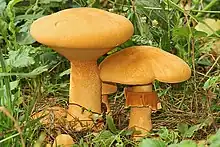Phaeolepiota
Phaeolepiota is a genus of fungi in the family Squamanitaceae. The genus is monotypic, containing the single species Phaeolepiota aurea. Commonly known as golden bootleg or golden cap, P. aurea is an agaric (gilled mushroom) found throughout North America and Eurasia – often in groups[1] and next to nettles.[2] Molecular research, based on cladistic analysis of DNA sequences, shows that Phaeolepiota is close to and may be congeneric with Cystoderma.[3][4]
| Phaeolepiota | |
|---|---|
 | |
| Phaeolepiota aurea | |
| Scientific classification | |
| Domain: | Eukaryota |
| Kingdom: | Fungi |
| Division: | Basidiomycota |
| Class: | Agaricomycetes |
| Order: | Agaricales |
| Family: | Squamanitaceae |
| Genus: | Phaeolepiota Maire ex Konrad & Maubl. (1928) |
| Type species | |
| Phaeolepiota aurea (Matt.) Maire (1928) | |
| Phaeolepiota aurea | |
|---|---|
| Gills on hymenium | |
| Cap is flat or convex | |
| Hymenium is free | |
| Stipe has a ring | |
| Spore print is reddish-brown | |
| Ecology is mycorrhizal | |
| Edibility is not recommended | |
Description
The mushroom is large and golden, and its stem has a skirt-like ring.[1] The spores are brown.[1]
Economic Usage
Fruit bodies of Phaeolepiota aurea have been considered edible and are collected for food in Russia and China.[5] It is not, however, recommended for consumption since it can cause gastrointestinal upset.[6] Studies have shown that fruit bodies contain unacceptable amounts of both cadmium and cyanide compounds. Cooking reduces the concentration of the cyanide compounds present, which may be the reason why Phaeolepiota aurea has been considered edible.[7]
References
- Trudell, Steve; Ammirati, Joe (2009). Mushrooms of the Pacific Northwest. Timber Press Field Guides. Portland, OR: Timber Press. p. 185. ISBN 978-0-88192-935-5.
- Phillips R (2005). Mushrooms and Other Fungi of North America. Firefly Books. p. 320. ISBN 978-1-55407-115-9.
- Liu JW, Ge ZW, Horak E, Vizzini A, Halling RE, Pan CL, Yang ZL (2021). "Squamanitaceae and three new species of Squamanita parasitic on Amanita basidiomes". IMA Fungus. 12 (1): 4. doi:10.1186/s43008-021-00057-z. PMC 7927255. PMID 33658081.
- Saar I, Thorn RG, Nagasawa E, Henkel TW, Cooper JA (2022). "A phylogenetic overview of Squamanita, with descriptions of nine new species and four new combinations". Mycologia. 114 (4): 769–797. doi:10.1080/00275514.2022.2059639. PMID 35695889. S2CID 249623155.
- Boa ER (2004). Wild Edible Fungi: A Global Overview Of Their Use And Importance To People (Non-Wood Forest Products). Food & Agriculture Organization of the UN. ISBN 978-92-5-105157-3.
- Miller Jr., Orson K.; Miller, Hope H. (2006). North American Mushrooms: A Field Guide to Edible and Inedible Fungi. Guilford, CN: FalconGuide. p. 260. ISBN 978-0-7627-3109-1.
- Phaeolepiota aurea mushroomthejournal.com Archived 2008-08-28 at the Wayback Machine
External links
 Media related to Phaeolepiota aurea at Wikimedia Commons
Media related to Phaeolepiota aurea at Wikimedia Commons